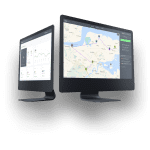Top courier industry problems [& tips for overcoming them!]
The courier industry continually grapples with obstacles, ranging from last-mile delivery hiccups to post-delivery complications. Whether you are a courier service or a brand contemplating an alliance, understanding these prevalent challenges equips you with the insights to tackle them effectively.
Overcoming the top 5 last-mile delivery challenges for courier drivers
Let us break down five of the most common courier issues and how to resolve them.
1. Vehicle breaks down
Facing a flat tyre on a bustling road or a non-starting truck post-delivery can be frustrating. To sidestep such issues, vehicle reliability is critical.
Tip:
Guidelines for maintaining your delivery vehicle in prime condition:s:
- Monthly tyre pressure checks, rotations, and inspections every 10,000 miles or less.
- Every 5,000 miles, assess car fluids such as oil, brake fluid, coolant, power steering, and transmission fluids.
- Employ a battery tester for routine battery checks.
- Arrange for an annual professional mechanic inspection and tune-up.
2. Run out of fuel
The inconvenience of an unscheduled fuel stop can disrupt your delivery timetable.
Tip:
Incorporate a daily fuel stop into your agenda and maintain at least a half-tank to ensure you never run out of petrol, even on hectic days.
3. Delivery delays
Speedy deliveries win customer satisfaction. An optimised route can reduce travel time and prevent issues like fuel shortages or getting lost.
Tip:
We strongly advise the use of a route-planning tool for route optimisation. These platforms account for variables such as traffic and weather, and many offer real-time updates for in-the-moment route adjustments.
4. Heavy Traffic
Traffic and tight schedules certainly do not go together.
Tip:
Route-planning tools excel in addressing this issue. Should you find yourself in a traffic jam, reschedule your subsequent stop to a later time. This approach minimises idle time and allows for efficient route reconfiguration.
5. Unfamiliar locations
Avoid jeopardising timely deliveries by getting lost. Ensure you are familiar with the route to your delivery location, mainly if it is a new destination.
Tip:
Methods to circumvent getting lost while delivering:
- Ensure your mapping application is current with the latest geographical data for your area.
- Dedicate a few minutes each morning to examine your planned route and identify unfamiliar stops.
- In cases where your mobile app or vehicle GPS lacks specific location details, keep a physical map of your region on hand.
What are large and independent courier companies’ top 5 last-mile delivery issues?
Even major courier firms are not immune to last-mile delivery challenges like their independent counterparts. Let us delve into these issues.
1. Competitive Market
When courier delivery comes to mind, big names like FedEx, UPS, and DHL often dominate the conversation. Their financial strength and technological edge make competition challenging for smaller couriers. Local businesses, therefore, need innovative strategies to sustain themselves in this cutthroat market.
Tip:
To stand out, offer bespoke services tailored to individual customer needs. If you operate a courier service, focus on creating specialised delivery options that address your client’s distinct requirements.
2. Human Error
In the expansive delivery industry, particularly in the digital age, the pressure for flawless execution is high. Regardless of employee training, errors are inevitable, especially during high-sales periods.
Tip:
Automation serves as an adequate remedy. Streamlining operations through automation brings several advantages, such as reduced errors, quicker processes, and cost-efficiency.
3. No visibility
Today’s customers value real-time delivery updates, often opting for the most transparent courier services. Therefore, keeping customers informed is crucial.
Tip:
The lack of real-time updates is unacceptable; hence, last-mile delivery tracking software is vital for success in this sector. Technology is critical; investment in top-tier solutions is necessary. Advanced tracking software should feature GPS systems for live package tracking, accurate delivery time estimates, and proof-of-delivery confirmations.
At GSMtasks, monitor your deliveries in real-time from pick-up to drop-off via a live map. Our digital chain of custody provides instant confirmations, and you can customise verification methods, including photos, signatures, emails, and texts.
4. Increased staff costs
Inefficient and convoluted workflows often stem from manual operations, leading to either staff overwork or underutilisation. Striking a balance between efficiency and team harmony is crucial, as is optimising staffing costs against profits.
Tip:
Automating the delivery process with route optimisation software can help reduce staffing expenses. Developing an on-demand courier app for non-commercial deliveries can mitigate operational risks associated with manual logistics management.
5. Changing demands
Understanding customer preferences in the ever-changing courier industry is challenging. Continual adaptation to meet shifting customer needs is essential.
Tip:
Customer research is pivotal for understanding your market, yet it is often overlooked. Direct engagement with customers is the most influential research method.
Common customer expectations include:
- Advocacy for their interests
- Accountability for results
- Availability for problem-solving
- Responsiveness to their needs
How technology transforms the courier industry
At a 10.1% annual rate, the market is anticipated to expand from $454.5 billion in 2020 to $736.0 billion in 2025. Technological advances will help mitigate expanding courier industry challenges.
1. Autonomous supply fleets
Speculation on how autonomous technologies will revolutionise global supply chains is rife. Ocean freight handles 90% of global goods, with 70% shipped in containers.
Firms like Rolls-Royce are contemplating drone-operated ships, commonly called “ghost ships.” Initial deployment is anticipated for 2025, with widespread adoption expected by 2030.
2. Autonomous moving freight
The shift towards autonomous vehicles is set to impact terrestrial transportation. With the global roll-out of 5G networks, such systems will gain ubiquity. Autonomous lorries are already operational in specific regions and are expected to become increasingly widespread in the coming decade.
3. Predictive logistics
Delivery times can be hit or miss.
Nevertheless, what if your package arrived before you even ordered it? That is the idea behind “anticipatory shipping,” something Amazon is currently experimenting with.
Companies already use predictive technology for purchase suggestions; anticipatory shipping extends this concept. Products are stored in local warehouses and distribution hubs. When a predicted order materialises, immediate shipment to the customer enables same-day delivery. Although ambitious, this strategy holds long-term promise.
4.3D Printing Factories
3D printing is set to gain prominence across various sectors, including the courier industry. Did you know one-third of daily-use items are 3D-printable? The vision involves industrial 3D printing centres serving as local hubs, printing and delivering orders within hours. Though still nascent, this concept is one to monitor closely shortly.
How GSMtasks can help solve courier industry problems
Courier services are vital in modern society, enabling swift package exchanges. Nevertheless, this sector is fraught with challenges, from demanding customer expectations to evolving regulatory landscapes.
Every industry has its hurdles, and the courier sector is no exception. This article discusses prevalent issues like delayed or misplaced deliveries, package damage, and subpar customer service. These challenges, though formidable, are surmountable with meticulous planning.
Utilising robust courier management software can mitigate many of these problems. Such systems enable operations analysis, activity tracking, customer trust-building via real-time SMS and email notifications, parcel tracking, and report generation, thus enhancing the overall efficacy of the courier industry.
The ecommerce courier delivery industries are the most significant contributors to harmful environmental impacts such as air pollution, climate change, ozone layer depletion, and other effects. Being a part of the industry, you can drive the change by adapting to eco-friendly ways of delivering products and contributing to improving the environment.
Using GSMtasks, you can transform towards eco-friendly delivery processing by following the shortest and optimised paths, requiring less fuel and reducing overall carbon emission.
Want to become more eco-friendly? Try GSMtasks! We have a FREE 14-day trial (no credit card required). Sign up and give it a try!
GSMtasks offers a 14-day free trial for all new users. The signup process for a free trial includes sharing information about your business so that the GSMtasks team can cater the perfect trial for your needs. During the trial period, you and your team will be supported in learning about the software and implementing its functions to maximise your company’s productivity.





